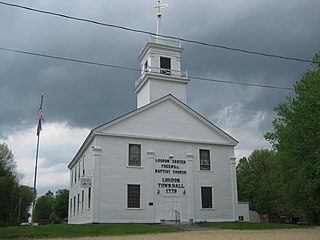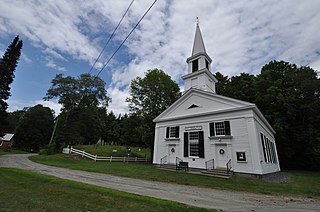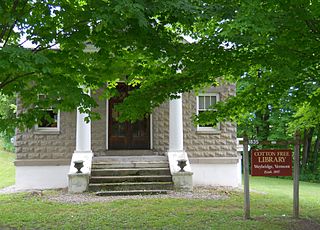
The Addison Community Baptist Church is a historic church building at 4970 Vermont Route 22A in the village center of Addison, Vermont. Built in 1816 and restyled in 1849, it is one of Vermont's oldest Baptist churches, and a good local example of Greek Revival architecture. It was listed on the National Register of Historic Places in 1978 as Addison Baptist Church.

St. Bartholomew's Episcopal Church is a historic church building located on Vermont Route 118 in Montgomery, Vermont in the United States. Its congregation was formed in 1821 as Union Episcopal Church. Church construction began in 1833 and was completed in 1835, when it was consecrated by the Rt. Rev. John Henry Hopkins, first bishop of the Episcopal Diocese of Vermont. In 1897 its name was changed to St. Bartholomew's Episcopal Church.

The Lower Warner Meetinghouse is a historic meetinghouse at 232 East Main Street in Warner, New Hampshire. Built in 1844–45, it is a little-altered example of a 19th-century Greek Revival church, which has retained nearly all of its original interior elements, as well as its exterior except for the steeple, lost to a lightning strike c. 1893. It was listed on the National Register of Historic Places in 1989.

Florona Grange No. 540 Hall is a historic Grange hall and former church on Monkton Road in Monkton, Vermont. Built in 1811 as the Monkton Borough Baptist Church, it is the second-oldest church in Addison County. it is a fine example of Federal architecture with later Greek Revival additions. Its initial design is based closely on designs published by Asher Benjamin. The building was added to the National Register of Historic Places in 1989.

The Starksboro Village Meeting House is a historic church and town hall on Vermont Route 116 in the village center of Starksboro, Vermont. It was built in 1838 as a cooperative venture between three church congregations and the town, and is a fine local example of Gothic Revival architecture. It was listed on the National Register of Historic Places in 1985.

The Swanton Christian Church, formerly the First Congregational Church of Swanton, Old Brick Meetinghouse, and New Wine Christian Fellowship is a historic church in the village of Swanton, Vermont. Built in 1823 and remodeled in 1869, it is a prominent landmark in the village, and a fine local example of Italianate styling on a Federal period building. It was listed on the National Register of Historic Places in 2001.

The Grand Isle United Methodist Church, formerly the Congregational Church—Grand Isle, is a historic church in Grand Isle, Vermont. Built in 1853–54, it is a well-preserved local example of Greek Revival architecture and the town's oldest surviving church building. Originally built for a Congregationalist group, it is now home to a United Methodist Church congregation. The church was listed on the National Register of Historic Places in 2001.

The United Church of Chelsea, previously the Congregational Church of Chelsea, is a historic church on Chelsea Green in Chelsea, Vermont. Built 1811–1813 with later stylistic additions, it is a fine example of Federal period architecture with Greek Revival alterations. Originally built for a Congregationalist group, it now serves as a union church, affiliated with the United Church of Christ. It was listed on the National Register of Historic Places in 1976.

The United Church of Ludlow, formerly the Congregational Church of Ludlow, is a historic church at 48 Pleasant Street in the village of Ludlow in Vermont. Built in 1891, it is one of the only churches in the state built in a fully mature expression of Shingle Style architecture. Its Congregationalist congregation was organized in 1806, and in 1930 it merged with a Methodist congregation to form a union congregation. The church was listed on the National Register of Historic Places in 2004.

Old Christ Church is a historic Episcopal church at the junction of Vermont Route 12 and Gilead Brook Road in Bethel, Vermont. Built in 1823, it is a well-preserved Federal period church, lacking modern amenities such as electricity and plumbing. The church was added to the National Register of Historic Places in 2008. It is used for services only during the summer.

The Centre Village Meeting House is a historic meeting house (church) on New Hampshire Route 4A in Enfield Center, New Hampshire. Built in 1836, it is a well-preserved late example of Federal period church architecture, albeit with some Greek Revival stylistic elements. Then as now, it serves as a nondenominational building, serving a variety of small Christian congregations. The building was listed on the National Register of Historic Places in 1985.

Loudon Town Hall is a historic New England meetinghouse at 433 Clough Hill Road in Loudon, New Hampshire. Built in 1779 and extensively restyled in 1847, this Greek Revival structure was used for many years for both religious and civic purposes; it now serves principally as a church, housing a Free Will Baptist congregation. The building was listed on the National Register of Historic Places in 1990; it is one of the oldest civic buildings in Merrimack County.

The Chesterville Community Church is an independent congregation in the Wesleyan tradition, located in the village of Chesterville, Ohio, United States. Founded in 1833, it is Chesterville's only church, and it worships in a landmark 1850s building. Constructed during the village's most prominent years, the building is one of the most significant structures anywhere in the community, and it has been named a historic site as an important part of the village's nineteenth-century built environment.

The Union Meetinghouse or Universalist Church is a historic church building at 97 Amesbury Road in Kensington, New Hampshire. Built in 1839–40, it is a well-preserved and little-altered example of a mid-19th century Greek Revival rural church. It was listed on the National Register of Historic Places in 2013, and continues to be used for summer services.

The Fowler-Steele House, also known historically as Ivy Hall, is a historic house on North Main Street in Windsor, Vermont, United States. Built in 1805 and restyled about 1850, it has an architecturally distinctive blend of Federal and Greek Revival styles. It served for many years as a local church parsonage. It was listed on the National Register of Historic Places in 1982.

The Ripton Community House, formerly the Ripton Congregational Church, is a historic former church and present community hall on Vermont Route 125 in the village of Ripton, Vermont. Built in 1864 for a Congregationalist church, it has since served as a community clubhouse and town-owned meeting hall, and is a fine local example of vernacular Greek Revival architecture. It was listed on the National Register of Historic Places in 1973.

The Waits River School is a historic school building on Vermont Route 25 in the Waits River village of Topsham, Vermont. Now a private residence, it was built in 1914 as a combination district school and Grange hall, serving in those roles until 1972 and 1953, respectively. It was listed on the National Register of Historic Places in 1988 for its Colonial Revival architecture and its importance in local educational history.

The West Fairlee Center Church is a historic church building at Middlebrook and Bear Notch Roads in West Fairlee, Vermont. Built in 1855, it is a fine and little-altered example of rural Greek Revival architecture, also notable for the association of its congregation with Nathaniel Niles, a prominent local minister, landowner, and politician. It was listed on the National Register of Historic Places in 2002.

The Cotton Free Library is the public library serving the town of Weybridge, Vermont. It is located on Quaker Village Road, in a small architecturally distinguished Colonial Revival building constructed in 1913 donated by Joshua Franklin Cotton. The building was listed on the National Register of Historic Places in 1996.

The District Number Four School is a historic district school building at 116 North Craftsbury Road in Craftsbury, Vermont. Built about 1859, it saw continuous use as a school building until 1980, and was soon afterward converted into a private residence. It was listed on the National Register of Historic Places in 2001.























